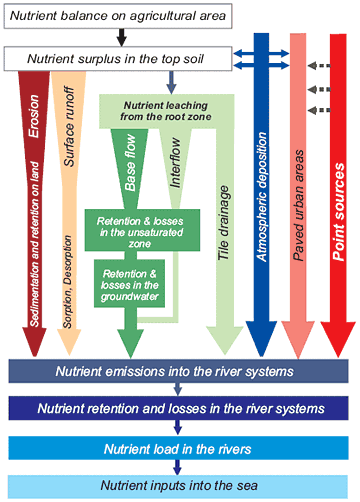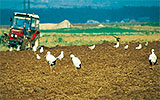daNUbs
DAnube NUtrients Black Sea
The daNUbs research project - cofunded by the EU - involves a large international and interdisciplinary research team from 16 partner institutions, co-ordinated by the Institute for Water Quality and Waste Management at the Vienna University of Technology.
General objectives
- to obtain information about the sources, pathways, stocks, losses and sinks of nutrients in a large river basin
- to increase understanding of the effects of nutrients (nitrogen, phosphorus and silica) on receiving ecosystems, particularly in coastal areas
- to improve and combine management tools used to measure and assess nutrients in the Danube Basin
- to develop scenarios and prognoses for nutrient management and the related impacts on water quality and socio-economic development in the Danube countries.
Initial results from the project include estimates of nutrient inputs into the river network, as well as an assessment of the loads of nitrogen, phosphorus and silica transported via the river network.
The results indicate that the negative inpacts of nutrients on the status of the Nort-western Black Sea has significantly improved since the 1980s. Nutrient levels within the Danube River Basin are relatively low in comparison to other basins, but good status with regard to the requirements of the WFD can only be achieved if future agricultural developments are based on best available practices.
The accuracy and reliability of the project results should be improved from 2005, thanks to the combination of three specific models – the GIS-based emission model (MONERIS) for calculating nutrient emissions, the Danube Water Quality Model for estimation of the transformation and transport of nutrients in the river, and the Danube Delta Model for nutrient transport through the Danube Delta.
The MONERIS approach
The application of the MONERIS (MOdelling Nutrient Emissions into RIver Systems) approach was successfully for the modeling of the nutrient inputs within the Danube River Basin. MONERIS is a semi-static emission model for point and diffuse sources of nutrients can also be adapted in order to deal also with heavy metals and some priority substances (e.g. Lindane).
Conceptually, MONERIS calculates the emissions into surface waters via several independent pathways for separate catchments, which are topologically linked in a tree-like structure (see figure below). Input data are taken from various sources (e.g. statistical yearbooks, emission inventories, digital maps etc). Those data were preprocessed to give specific values for every catchment.
For MONERIS a harmonized database was established for all Danube countries. Results have been used in the Roof Report 2004 for the assessment of point and diffuse nutrient inputs into the Danube River Baisn.

Disclaimer
The information contained in the ICPDR website is intended to enhance public access to information about the ICPDR and the Danube River. The information is correct to the best of the knowledge of the ICPDR Secretariat. If errors are brought to our attention we will try to correct them.
The ICPDR, expert group members, nor other parties involved in preparation of information contained on this website cannot, however, be held responsible for the correctness and validity of the data and information provided, nor accept responsibility or liability for damages or losses arising directly or indirectly from the use of the information conveyed therein.
Only those documents clearly marked ICPDR documents reflect the position of the ICPDR.
Any links to other websites are provided for your convenience only. The ICPDR does not accept any responsibility for the accuracy, availability, or appropriateness to the user's purposes, of any information or services on any other website.
When using the information and material provided on this website, credit should be given to the ICPDR.

